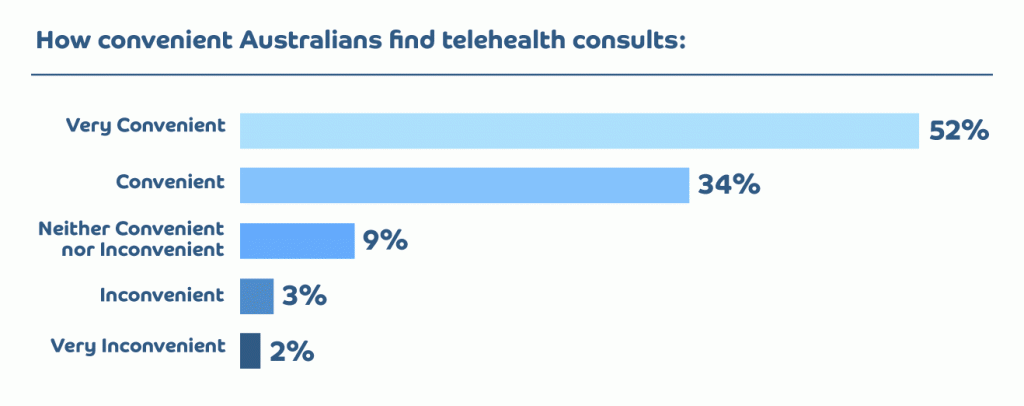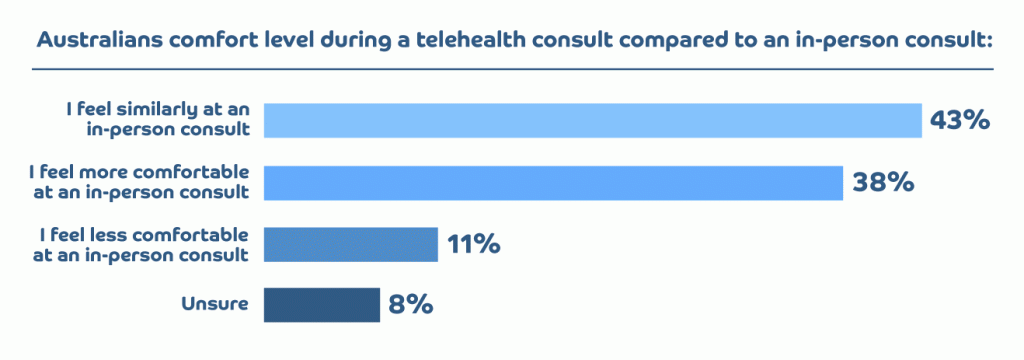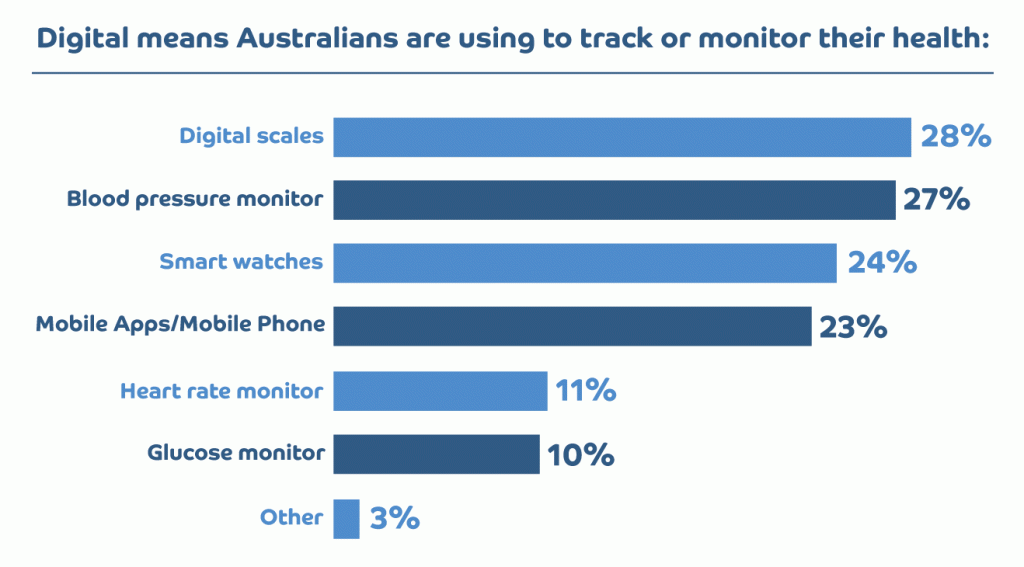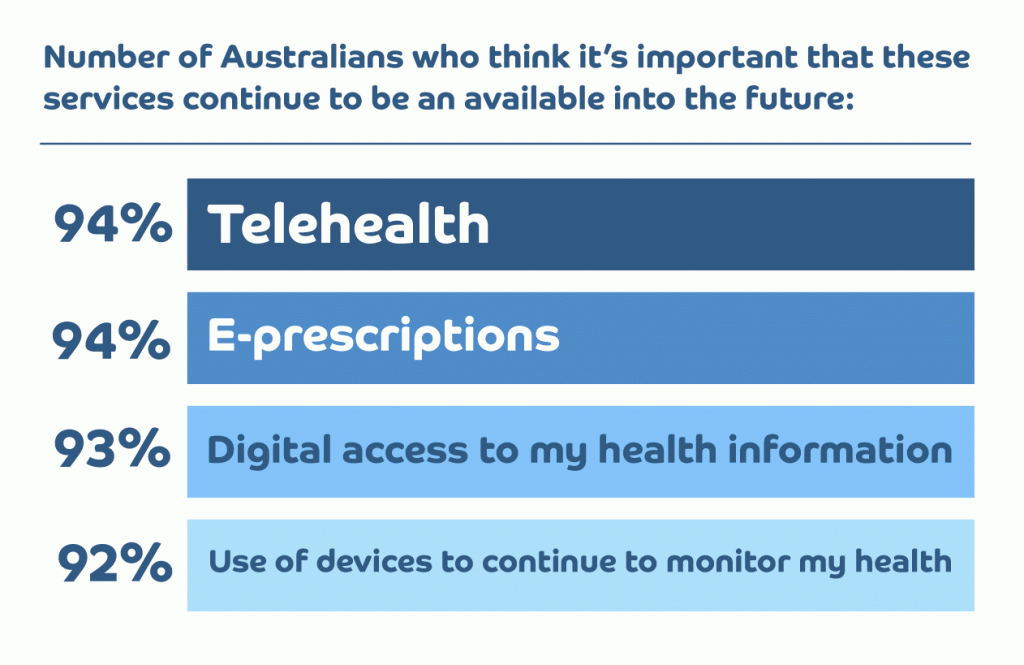Telehealth; appointments from healthcare providers conducted over telephone or a video application such as Zoom, have become widely accepted as the new norm for Australians when it comes to managing their health. Now that the nation is free of lockdowns, will Australians revert to traditional in-person visits to the doctor and other health services, or will this shift be more permanent? A joint Apple A Day Research and Select Opinion Leaders poll surveyed Australians about their telehealth experiences so far, to understand how the care measures up against in-person consults and the future impact of Telehealth and technology in healthcare.
Who’s Been Using Telehealth?
This alternative to in-person visits was so widely adapted by Australia’s healthcare industry over the past 18 months, that 74% of Australians aged over 18 have now used a Telehealth service. The concept is no doubt the most convenient option for most – 87% of those who have used it described it as so. Time is saved by not travelling to the appointment, and rather than sit in a waiting room patients can be productive in their homes or workplaces whilst they wait.
Telehealth services have been utilised by Australians of all ages, although those over the age of 60 are disproportionally less likely to have done so compared to the rest of the country.
How Does Telehealth Compare?
Convenient as it may be, do Australians find the outcome of a Telehealth consultation to be as satisfactory as face-to-face? Of those polled who have utilised Telehealth, 8 out of 10 Australians were satisfied with the experience and 83% state they’d likely promote its use to family and friends.
In terms of how comfortable they felt discussing their healthcare concerns over phone or video, one in ten Aussies who’ve used Telehealth felt less comfortable than if they were face-to-face with their practitioner. Mostly though, people find minimal difference between the two in terms of comfort levels (43%), and many Australians find Telehealth to be more comfortable than in-person visits (38%).
Nearly a third of Australian Telehealth users also reported that they had found the services to be more affordable than in-person consultations (27%). More commonly it was said to be the same cost (54%), but a small number of people found it ended up being more expensive. An example of how this might occur is if a patient makes a Telehealth appointment to discuss a concern but is then told to make an in-person appointment for a physical examination.
How Do We Decide If We Need a Telehealth or an In-Person Consult?
Given most doctor’s appointments are for physical health, it can be hard to imagine Telehealth being the preferred or most effective option, given a physical examination is not possible in the same capacity over the phone or even via video. But presented with the opportunity of convenience, Australians will have to start making decisions for themselves on whether to book a Telehealth or in-person consult.
Prior to the rise of telehealth, when Australians had an in-person health consult, 60% said that any physical examinations they received were on parts of the body that they already suspected to be the cause of the ailment. This means that a lot of the time Australians are likely capable of deciding whether the physical examination would be possible through the Telehealth system.
The most common type of physical examination Australians reported to be a part of their health care, prior to Covid-19 was blood pressure readings (72%). A relatively simple task to preform, a quarter of Australians polled are in fact completing this at home themselves. This may be one of the many potential futures for healthcare in Australia; the use of technology and self-conducted examinations supported by Telehealth consultations with professionals…
Telehealth and Technology Combine to Pave the Future of Healthcare…
Age is not only a factor of whether a person has used Telehealth, but in what capacity they have adopted the use of technology for their healthcare. In helping to bridge the communication gap of not being face-to-face, around one in ten Australians have even electronically sent images of their issues to their healthcare professionals (9%).
This strategy has predominantly been adopted by younger Australians; those aged between 30 and 39 are nearly double as likely to have already sent their healthcare provider a diagnostic image through technology (16%) than Australians aged between 50 and 59 (9%) and are five times more likely to have than those aged over 60 (3%).
Adapting technology into healthcare was not a new concept for younger Australians. Our poll suggests that around half of all Australians under the age of 30 are using smart watches and/or their phones to monitor their physical well-being, significantly more so than the national average (24% for smart watch use, and 23% for phone use for health monitoring).
Approximately 14% of Australian Telehealth users aged under 40 even believe that this new form of health consultation could replace all requirements to visit a doctor in the future. With the help of technology, Telehealth could mean the your local general practitioners office may become as obsolete as banks have become for young Australians and take on more specialist-style appointments following on from a telehealth consult.
Is Telehealth a More Accessible Form of Healthcare?
Telehealth may be creating more efficiency, saving time and costs, but what does it mean for the patient/practitioner relationship? Will it be harder to build trust with our healthcare providers over the distance of using technology? Our poll suggests otherwise for around half of all Australian Telehealth users, who say that it has made it easier to connect with their healthcare provider, in terms of check-ups and discussing health concerns (50%).
For some Australians however, adapting to the process and technology of Telehealth proves more challenging. Overall, one in five Australians reported that there are factors that create a banner for them to use telehealth services, most commonly pertaining to accessibility issues (33%), followed by a lack of knowledge of how to use technology to do so (18%).
Whilst for the majority of Australians who have experienced Telehealth say that it was easy to use (94%), there is a minority that is being left behind during this shift towards technology-reliant healthcare.
Will Australia Continue to Telehealth in The Future?
Going forward, 70% of Australians who have already tried a telehealth service say they are likely to continue to use this option. In fact, 77% state that the continuation of telehealth is important to them, as is the continuation of e-prescriptions for around 8 in 10 Australians (79%).
Prior to the pandemic, Australians had a more relaxed outlook on the concept of contagion. When you got a cold or virus and needed a doctor’s certificate in order to file a sick day from work, you had to visit your doctor. Given our renewed appreciation for transmission of illness, bringing all the sick people into a shared community space now feels counterproductive and outdated. Regardless all the other benefits, Telehealth has a place in making community spaces safer through reduced transmission of other illnesses.
The Future Impact of Telehealth…
Telehealth brings with it so many benefits in the form of efficiency, comfort, and safety. It has helped change the nation’s acceptance of technology use within their healthcare and will likely continue to be a staple for the industry. With this in mind, we must consider the impacts of these changes in the way Australians connect with both their health professionals and with their own understanding of their health.
Since Telehealth became commonplace, 61% of Australians state that if they feel they need a physical examination then they will make an in-person appointment. However, a quarter of Australians say that because of Telehealth they now get physical examinations less often (25%). While it may be that this reduction is because there wasn’t need for the in-person examinations in the first place, as a society we need to ensure that inadequate monitoring (by either incorrectly performed at-home health checks, or by patients receiving check-ups less frequently) doesn’t lead to increase in preventable conditions.
On the other side of the coin, the need to decide between the convenience of booking a telehealth consult, versus the necessity to visit a healthcare professional in-person, may result in Australians thinking more thoroughly about their health. Combined with the increasing popularity of smart watches, apps and other technology for at-home monitoring, Telehealth may well be encouraging Australian to be more in touch with their bodies, symptoms and conditions.
With 64% of Australian Telehealth users believing that these services allow for a better way to engage with health providers, Telehealth may be reshaping Australia’s healthcare industry for a more efficient, engaged, and health-aware future.
Ekas spoke to 1171 members on it’s panels Apple A Day Research and Select Opinion Leaders in October 2021




